Substance Abuse Intake Assessment
VerifiedAdded on 2020/05/28
|6
|2690
|266
AI Summary
This assignment presents a detailed case study of 'Sue', an individual struggling with drug addiction. The document analyzes her personal history marked by trauma and hardship, which likely contributed to her substance abuse. It outlines various treatment options suitable for Sue, such as chemical dependence programs, detoxification, behavior therapy, and self-help groups. The assignment also emphasizes the importance of a comprehensive diagnosis based on DSM-5 criteria.
Contribute Materials
Your contribution can guide someone’s learning journey. Share your
documents today.
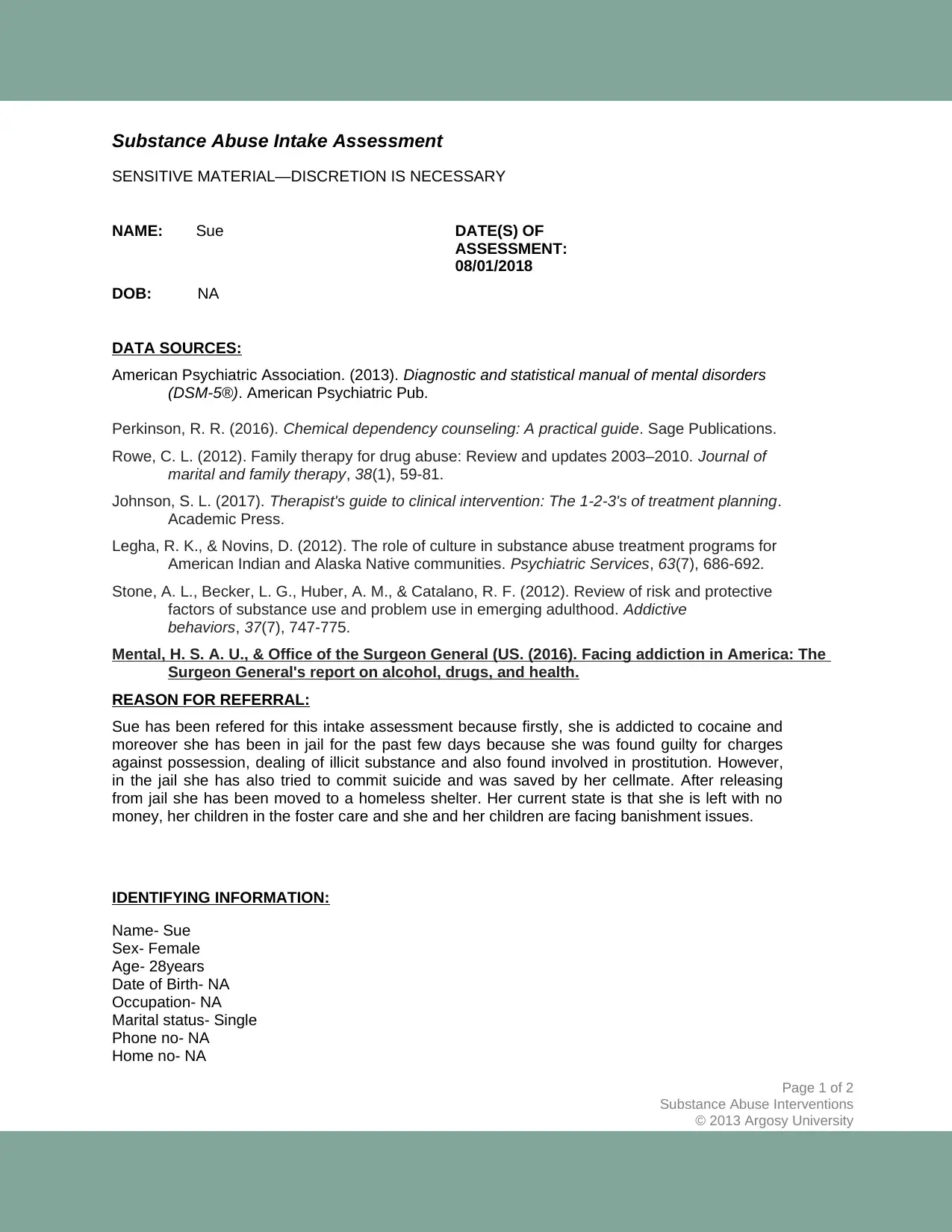
Substance Abuse Intake Assessment
SENSITIVE MATERIAL—DISCRETION IS NECESSARY
NAME: Sue DATE(S) OF
ASSESSMENT:
08/01/2018
DOB: NA
DATA SOURCES:
American Psychiatric Association. (2013). Diagnostic and statistical manual of mental disorders
(DSM-5®). American Psychiatric Pub.
Perkinson, R. R. (2016). Chemical dependency counseling: A practical guide. Sage Publications.
Rowe, C. L. (2012). Family therapy for drug abuse: Review and updates 2003–2010. Journal of
marital and family therapy, 38(1), 59-81.
Johnson, S. L. (2017). Therapist's guide to clinical intervention: The 1-2-3's of treatment planning.
Academic Press.
Legha, R. K., & Novins, D. (2012). The role of culture in substance abuse treatment programs for
American Indian and Alaska Native communities. Psychiatric Services, 63(7), 686-692.
Stone, A. L., Becker, L. G., Huber, A. M., & Catalano, R. F. (2012). Review of risk and protective
factors of substance use and problem use in emerging adulthood. Addictive
behaviors, 37(7), 747-775.
Mental, H. S. A. U., & Office of the Surgeon General (US. (2016). Facing addiction in America: The
Surgeon General's report on alcohol, drugs, and health.
REASON FOR REFERRAL:
Sue has been refered for this intake assessment because firstly, she is addicted to cocaine and
moreover she has been in jail for the past few days because she was found guilty for charges
against possession, dealing of illicit substance and also found involved in prostitution. However,
in the jail she has also tried to commit suicide and was saved by her cellmate. After releasing
from jail she has been moved to a homeless shelter. Her current state is that she is left with no
money, her children in the foster care and she and her children are facing banishment issues.
IDENTIFYING INFORMATION:
Name- Sue
Sex- Female
Age- 28years
Date of Birth- NA
Occupation- NA
Marital status- Single
Phone no- NA
Home no- NA
Page 1 of 2
Substance Abuse Interventions
© 2013 Argosy University
SENSITIVE MATERIAL—DISCRETION IS NECESSARY
NAME: Sue DATE(S) OF
ASSESSMENT:
08/01/2018
DOB: NA
DATA SOURCES:
American Psychiatric Association. (2013). Diagnostic and statistical manual of mental disorders
(DSM-5®). American Psychiatric Pub.
Perkinson, R. R. (2016). Chemical dependency counseling: A practical guide. Sage Publications.
Rowe, C. L. (2012). Family therapy for drug abuse: Review and updates 2003–2010. Journal of
marital and family therapy, 38(1), 59-81.
Johnson, S. L. (2017). Therapist's guide to clinical intervention: The 1-2-3's of treatment planning.
Academic Press.
Legha, R. K., & Novins, D. (2012). The role of culture in substance abuse treatment programs for
American Indian and Alaska Native communities. Psychiatric Services, 63(7), 686-692.
Stone, A. L., Becker, L. G., Huber, A. M., & Catalano, R. F. (2012). Review of risk and protective
factors of substance use and problem use in emerging adulthood. Addictive
behaviors, 37(7), 747-775.
Mental, H. S. A. U., & Office of the Surgeon General (US. (2016). Facing addiction in America: The
Surgeon General's report on alcohol, drugs, and health.
REASON FOR REFERRAL:
Sue has been refered for this intake assessment because firstly, she is addicted to cocaine and
moreover she has been in jail for the past few days because she was found guilty for charges
against possession, dealing of illicit substance and also found involved in prostitution. However,
in the jail she has also tried to commit suicide and was saved by her cellmate. After releasing
from jail she has been moved to a homeless shelter. Her current state is that she is left with no
money, her children in the foster care and she and her children are facing banishment issues.
IDENTIFYING INFORMATION:
Name- Sue
Sex- Female
Age- 28years
Date of Birth- NA
Occupation- NA
Marital status- Single
Phone no- NA
Home no- NA
Page 1 of 2
Substance Abuse Interventions
© 2013 Argosy University
Secure Best Marks with AI Grader
Need help grading? Try our AI Grader for instant feedback on your assignments.
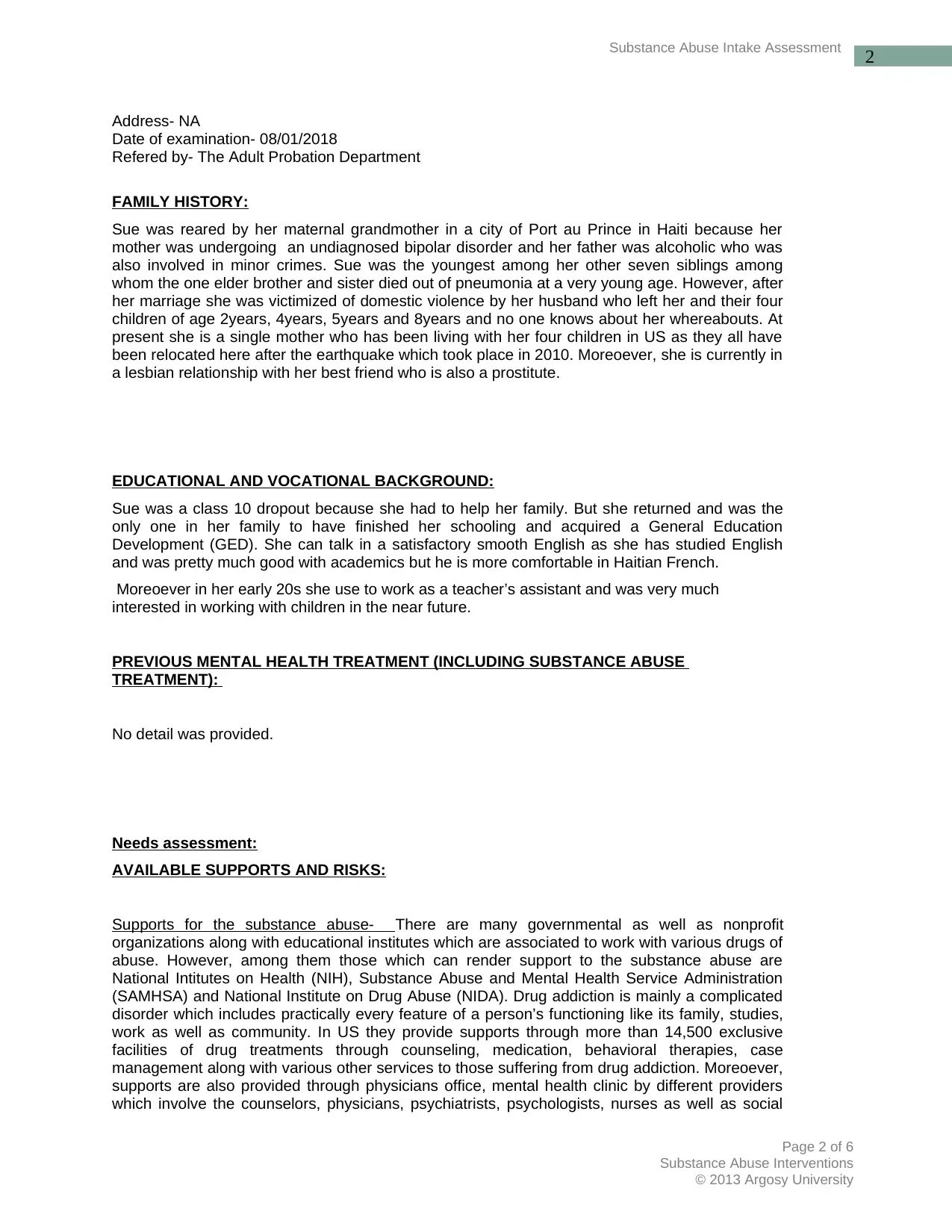
2
Substance Abuse Intake Assessment
Address- NA
Date of examination- 08/01/2018
Refered by- The Adult Probation Department
FAMILY HISTORY:
Sue was reared by her maternal grandmother in a city of Port au Prince in Haiti because her
mother was undergoing an undiagnosed bipolar disorder and her father was alcoholic who was
also involved in minor crimes. Sue was the youngest among her other seven siblings among
whom the one elder brother and sister died out of pneumonia at a very young age. However, after
her marriage she was victimized of domestic violence by her husband who left her and their four
children of age 2years, 4years, 5years and 8years and no one knows about her whereabouts. At
present she is a single mother who has been living with her four children in US as they all have
been relocated here after the earthquake which took place in 2010. Moreoever, she is currently in
a lesbian relationship with her best friend who is also a prostitute.
EDUCATIONAL AND VOCATIONAL BACKGROUND:
Sue was a class 10 dropout because she had to help her family. But she returned and was the
only one in her family to have finished her schooling and acquired a General Education
Development (GED). She can talk in a satisfactory smooth English as she has studied English
and was pretty much good with academics but he is more comfortable in Haitian French.
Moreoever in her early 20s she use to work as a teacher’s assistant and was very much
interested in working with children in the near future.
PREVIOUS MENTAL HEALTH TREATMENT (INCLUDING SUBSTANCE ABUSE
TREATMENT):
No detail was provided.
Needs assessment:
AVAILABLE SUPPORTS AND RISKS:
Supports for the substance abuse- There are many governmental as well as nonprofit
organizations along with educational institutes which are associated to work with various drugs of
abuse. However, among them those which can render support to the substance abuse are
National Intitutes on Health (NIH), Substance Abuse and Mental Health Service Administration
(SAMHSA) and National Institute on Drug Abuse (NIDA). Drug addiction is mainly a complicated
disorder which includes practically every feature of a person’s functioning like its family, studies,
work as well as community. In US they provide supports through more than 14,500 exclusive
facilities of drug treatments through counseling, medication, behavioral therapies, case
management along with various other services to those suffering from drug addiction. Moreoever,
supports are also provided through physicians office, mental health clinic by different providers
which involve the counselors, physicians, psychiatrists, psychologists, nurses as well as social
Page 2 of 6
Substance Abuse Interventions
© 2013 Argosy University
Substance Abuse Intake Assessment
Address- NA
Date of examination- 08/01/2018
Refered by- The Adult Probation Department
FAMILY HISTORY:
Sue was reared by her maternal grandmother in a city of Port au Prince in Haiti because her
mother was undergoing an undiagnosed bipolar disorder and her father was alcoholic who was
also involved in minor crimes. Sue was the youngest among her other seven siblings among
whom the one elder brother and sister died out of pneumonia at a very young age. However, after
her marriage she was victimized of domestic violence by her husband who left her and their four
children of age 2years, 4years, 5years and 8years and no one knows about her whereabouts. At
present she is a single mother who has been living with her four children in US as they all have
been relocated here after the earthquake which took place in 2010. Moreoever, she is currently in
a lesbian relationship with her best friend who is also a prostitute.
EDUCATIONAL AND VOCATIONAL BACKGROUND:
Sue was a class 10 dropout because she had to help her family. But she returned and was the
only one in her family to have finished her schooling and acquired a General Education
Development (GED). She can talk in a satisfactory smooth English as she has studied English
and was pretty much good with academics but he is more comfortable in Haitian French.
Moreoever in her early 20s she use to work as a teacher’s assistant and was very much
interested in working with children in the near future.
PREVIOUS MENTAL HEALTH TREATMENT (INCLUDING SUBSTANCE ABUSE
TREATMENT):
No detail was provided.
Needs assessment:
AVAILABLE SUPPORTS AND RISKS:
Supports for the substance abuse- There are many governmental as well as nonprofit
organizations along with educational institutes which are associated to work with various drugs of
abuse. However, among them those which can render support to the substance abuse are
National Intitutes on Health (NIH), Substance Abuse and Mental Health Service Administration
(SAMHSA) and National Institute on Drug Abuse (NIDA). Drug addiction is mainly a complicated
disorder which includes practically every feature of a person’s functioning like its family, studies,
work as well as community. In US they provide supports through more than 14,500 exclusive
facilities of drug treatments through counseling, medication, behavioral therapies, case
management along with various other services to those suffering from drug addiction. Moreoever,
supports are also provided through physicians office, mental health clinic by different providers
which involve the counselors, physicians, psychiatrists, psychologists, nurses as well as social
Page 2 of 6
Substance Abuse Interventions
© 2013 Argosy University
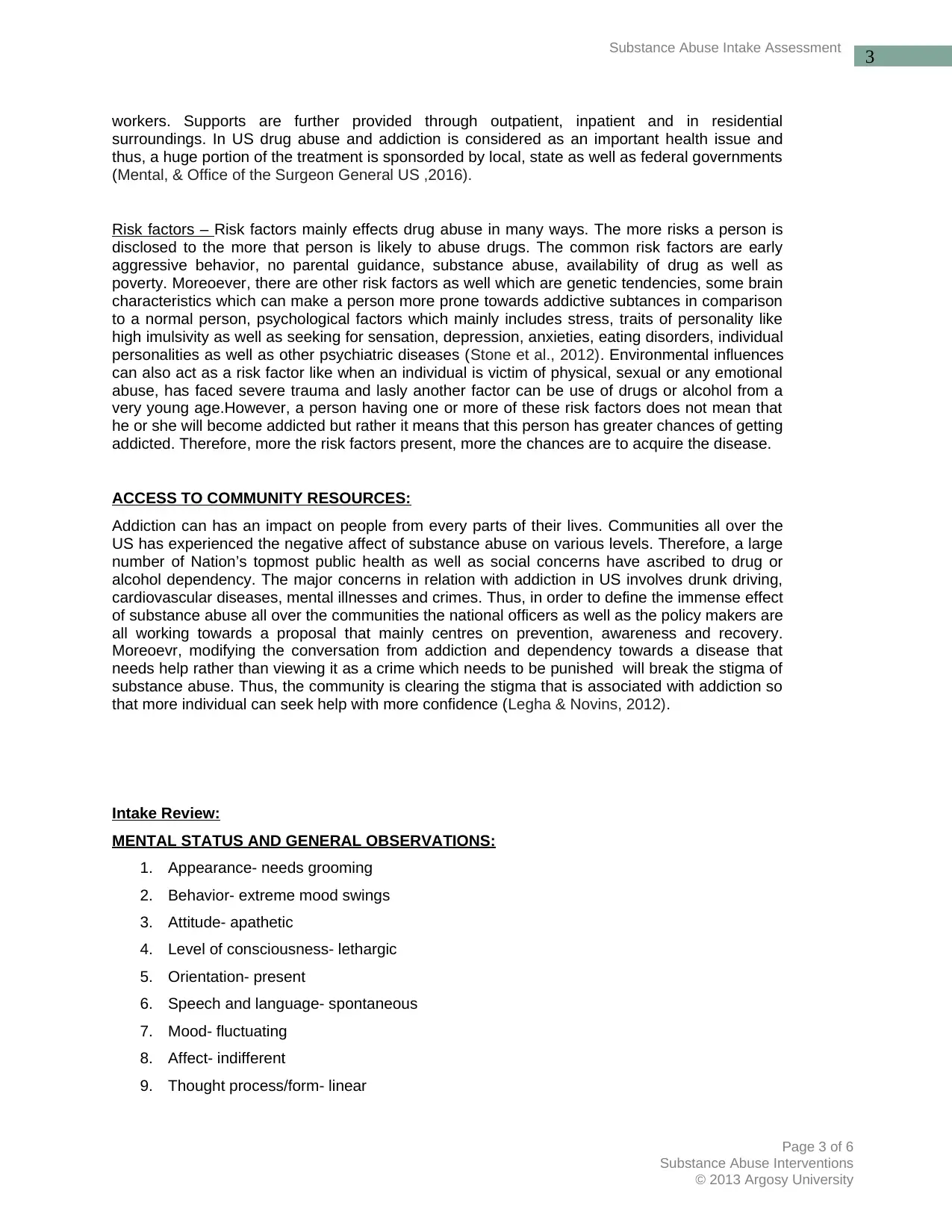
3
Substance Abuse Intake Assessment
workers. Supports are further provided through outpatient, inpatient and in residential
surroundings. In US drug abuse and addiction is considered as an important health issue and
thus, a huge portion of the treatment is sponsorded by local, state as well as federal governments
(Mental, & Office of the Surgeon General US ,2016).
Risk factors – Risk factors mainly effects drug abuse in many ways. The more risks a person is
disclosed to the more that person is likely to abuse drugs. The common risk factors are early
aggressive behavior, no parental guidance, substance abuse, availability of drug as well as
poverty. Moreoever, there are other risk factors as well which are genetic tendencies, some brain
characteristics which can make a person more prone towards addictive subtances in comparison
to a normal person, psychological factors which mainly includes stress, traits of personality like
high imulsivity as well as seeking for sensation, depression, anxieties, eating disorders, individual
personalities as well as other psychiatric diseases (Stone et al., 2012). Environmental influences
can also act as a risk factor like when an individual is victim of physical, sexual or any emotional
abuse, has faced severe trauma and lasly another factor can be use of drugs or alcohol from a
very young age.However, a person having one or more of these risk factors does not mean that
he or she will become addicted but rather it means that this person has greater chances of getting
addicted. Therefore, more the risk factors present, more the chances are to acquire the disease.
ACCESS TO COMMUNITY RESOURCES:
Addiction can has an impact on people from every parts of their lives. Communities all over the
US has experienced the negative affect of substance abuse on various levels. Therefore, a large
number of Nation’s topmost public health as well as social concerns have ascribed to drug or
alcohol dependency. The major concerns in relation with addiction in US involves drunk driving,
cardiovascular diseases, mental illnesses and crimes. Thus, in order to define the immense effect
of substance abuse all over the communities the national officers as well as the policy makers are
all working towards a proposal that mainly centres on prevention, awareness and recovery.
Moreoevr, modifying the conversation from addiction and dependency towards a disease that
needs help rather than viewing it as a crime which needs to be punished will break the stigma of
substance abuse. Thus, the community is clearing the stigma that is associated with addiction so
that more individual can seek help with more confidence (Legha & Novins, 2012).
Intake Review:
MENTAL STATUS AND GENERAL OBSERVATIONS:
1. Appearance- needs grooming
2. Behavior- extreme mood swings
3. Attitude- apathetic
4. Level of consciousness- lethargic
5. Orientation- present
6. Speech and language- spontaneous
7. Mood- fluctuating
8. Affect- indifferent
9. Thought process/form- linear
Page 3 of 6
Substance Abuse Interventions
© 2013 Argosy University
Substance Abuse Intake Assessment
workers. Supports are further provided through outpatient, inpatient and in residential
surroundings. In US drug abuse and addiction is considered as an important health issue and
thus, a huge portion of the treatment is sponsorded by local, state as well as federal governments
(Mental, & Office of the Surgeon General US ,2016).
Risk factors – Risk factors mainly effects drug abuse in many ways. The more risks a person is
disclosed to the more that person is likely to abuse drugs. The common risk factors are early
aggressive behavior, no parental guidance, substance abuse, availability of drug as well as
poverty. Moreoever, there are other risk factors as well which are genetic tendencies, some brain
characteristics which can make a person more prone towards addictive subtances in comparison
to a normal person, psychological factors which mainly includes stress, traits of personality like
high imulsivity as well as seeking for sensation, depression, anxieties, eating disorders, individual
personalities as well as other psychiatric diseases (Stone et al., 2012). Environmental influences
can also act as a risk factor like when an individual is victim of physical, sexual or any emotional
abuse, has faced severe trauma and lasly another factor can be use of drugs or alcohol from a
very young age.However, a person having one or more of these risk factors does not mean that
he or she will become addicted but rather it means that this person has greater chances of getting
addicted. Therefore, more the risk factors present, more the chances are to acquire the disease.
ACCESS TO COMMUNITY RESOURCES:
Addiction can has an impact on people from every parts of their lives. Communities all over the
US has experienced the negative affect of substance abuse on various levels. Therefore, a large
number of Nation’s topmost public health as well as social concerns have ascribed to drug or
alcohol dependency. The major concerns in relation with addiction in US involves drunk driving,
cardiovascular diseases, mental illnesses and crimes. Thus, in order to define the immense effect
of substance abuse all over the communities the national officers as well as the policy makers are
all working towards a proposal that mainly centres on prevention, awareness and recovery.
Moreoevr, modifying the conversation from addiction and dependency towards a disease that
needs help rather than viewing it as a crime which needs to be punished will break the stigma of
substance abuse. Thus, the community is clearing the stigma that is associated with addiction so
that more individual can seek help with more confidence (Legha & Novins, 2012).
Intake Review:
MENTAL STATUS AND GENERAL OBSERVATIONS:
1. Appearance- needs grooming
2. Behavior- extreme mood swings
3. Attitude- apathetic
4. Level of consciousness- lethargic
5. Orientation- present
6. Speech and language- spontaneous
7. Mood- fluctuating
8. Affect- indifferent
9. Thought process/form- linear
Page 3 of 6
Substance Abuse Interventions
© 2013 Argosy University
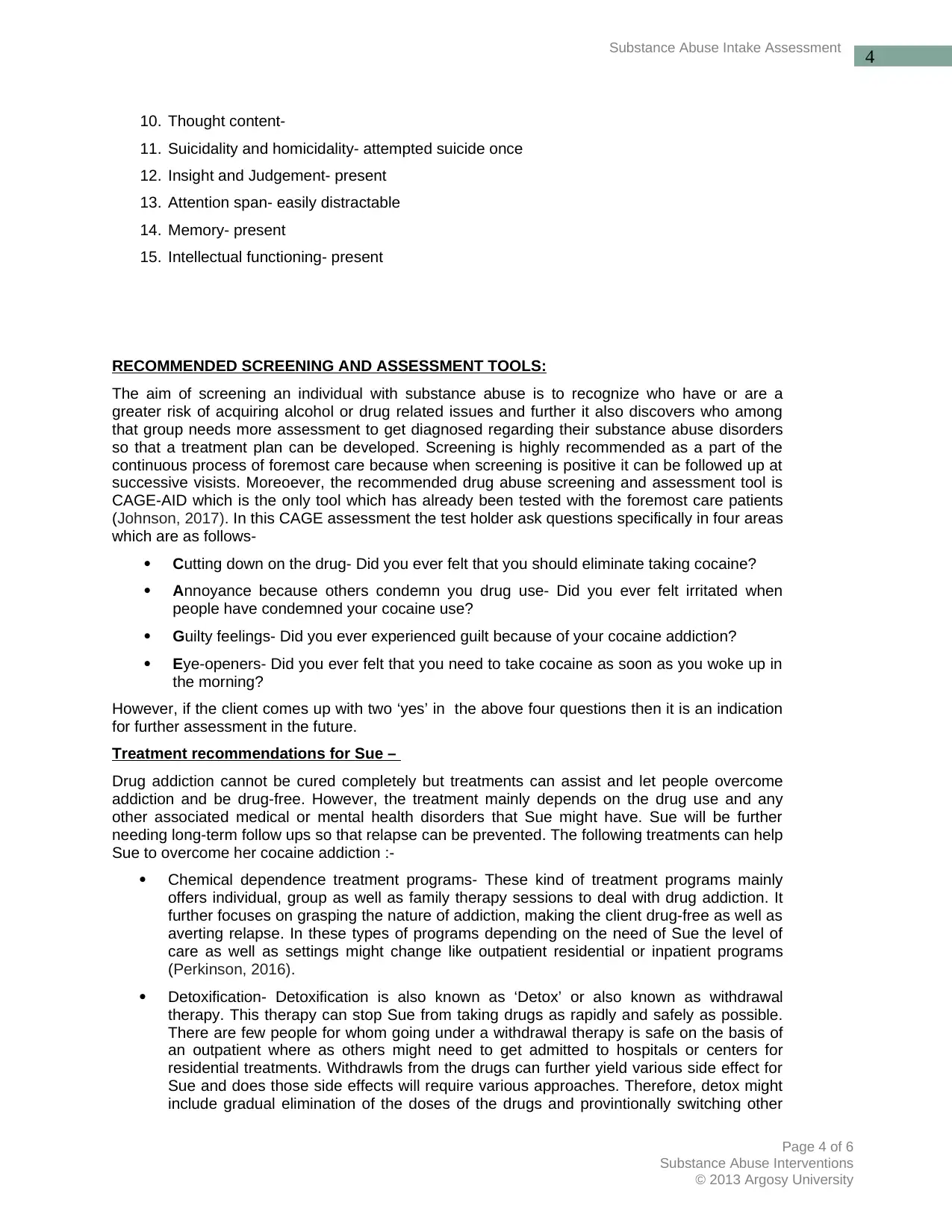
4
Substance Abuse Intake Assessment
10. Thought content-
11. Suicidality and homicidality- attempted suicide once
12. Insight and Judgement- present
13. Attention span- easily distractable
14. Memory- present
15. Intellectual functioning- present
RECOMMENDED SCREENING AND ASSESSMENT TOOLS:
The aim of screening an individual with substance abuse is to recognize who have or are a
greater risk of acquiring alcohol or drug related issues and further it also discovers who among
that group needs more assessment to get diagnosed regarding their substance abuse disorders
so that a treatment plan can be developed. Screening is highly recommended as a part of the
continuous process of foremost care because when screening is positive it can be followed up at
successive visists. Moreoever, the recommended drug abuse screening and assessment tool is
CAGE-AID which is the only tool which has already been tested with the foremost care patients
(Johnson, 2017). In this CAGE assessment the test holder ask questions specifically in four areas
which are as follows-
Cutting down on the drug- Did you ever felt that you should eliminate taking cocaine?
Annoyance because others condemn you drug use- Did you ever felt irritated when
people have condemned your cocaine use?
Guilty feelings- Did you ever experienced guilt because of your cocaine addiction?
Eye-openers- Did you ever felt that you need to take cocaine as soon as you woke up in
the morning?
However, if the client comes up with two ‘yes’ in the above four questions then it is an indication
for further assessment in the future.
Treatment recommendations for Sue –
Drug addiction cannot be cured completely but treatments can assist and let people overcome
addiction and be drug-free. However, the treatment mainly depends on the drug use and any
other associated medical or mental health disorders that Sue might have. Sue will be further
needing long-term follow ups so that relapse can be prevented. The following treatments can help
Sue to overcome her cocaine addiction :-
Chemical dependence treatment programs- These kind of treatment programs mainly
offers individual, group as well as family therapy sessions to deal with drug addiction. It
further focuses on grasping the nature of addiction, making the client drug-free as well as
averting relapse. In these types of programs depending on the need of Sue the level of
care as well as settings might change like outpatient residential or inpatient programs
(Perkinson, 2016).
Detoxification- Detoxification is also known as ‘Detox’ or also known as withdrawal
therapy. This therapy can stop Sue from taking drugs as rapidly and safely as possible.
There are few people for whom going under a withdrawal therapy is safe on the basis of
an outpatient where as others might need to get admitted to hospitals or centers for
residential treatments. Withdrawls from the drugs can further yield various side effect for
Sue and does those side effects will require various approaches. Therefore, detox might
include gradual elimination of the doses of the drugs and provintionally switching other
Page 4 of 6
Substance Abuse Interventions
© 2013 Argosy University
Substance Abuse Intake Assessment
10. Thought content-
11. Suicidality and homicidality- attempted suicide once
12. Insight and Judgement- present
13. Attention span- easily distractable
14. Memory- present
15. Intellectual functioning- present
RECOMMENDED SCREENING AND ASSESSMENT TOOLS:
The aim of screening an individual with substance abuse is to recognize who have or are a
greater risk of acquiring alcohol or drug related issues and further it also discovers who among
that group needs more assessment to get diagnosed regarding their substance abuse disorders
so that a treatment plan can be developed. Screening is highly recommended as a part of the
continuous process of foremost care because when screening is positive it can be followed up at
successive visists. Moreoever, the recommended drug abuse screening and assessment tool is
CAGE-AID which is the only tool which has already been tested with the foremost care patients
(Johnson, 2017). In this CAGE assessment the test holder ask questions specifically in four areas
which are as follows-
Cutting down on the drug- Did you ever felt that you should eliminate taking cocaine?
Annoyance because others condemn you drug use- Did you ever felt irritated when
people have condemned your cocaine use?
Guilty feelings- Did you ever experienced guilt because of your cocaine addiction?
Eye-openers- Did you ever felt that you need to take cocaine as soon as you woke up in
the morning?
However, if the client comes up with two ‘yes’ in the above four questions then it is an indication
for further assessment in the future.
Treatment recommendations for Sue –
Drug addiction cannot be cured completely but treatments can assist and let people overcome
addiction and be drug-free. However, the treatment mainly depends on the drug use and any
other associated medical or mental health disorders that Sue might have. Sue will be further
needing long-term follow ups so that relapse can be prevented. The following treatments can help
Sue to overcome her cocaine addiction :-
Chemical dependence treatment programs- These kind of treatment programs mainly
offers individual, group as well as family therapy sessions to deal with drug addiction. It
further focuses on grasping the nature of addiction, making the client drug-free as well as
averting relapse. In these types of programs depending on the need of Sue the level of
care as well as settings might change like outpatient residential or inpatient programs
(Perkinson, 2016).
Detoxification- Detoxification is also known as ‘Detox’ or also known as withdrawal
therapy. This therapy can stop Sue from taking drugs as rapidly and safely as possible.
There are few people for whom going under a withdrawal therapy is safe on the basis of
an outpatient where as others might need to get admitted to hospitals or centers for
residential treatments. Withdrawls from the drugs can further yield various side effect for
Sue and does those side effects will require various approaches. Therefore, detox might
include gradual elimination of the doses of the drugs and provintionally switching other
Page 4 of 6
Substance Abuse Interventions
© 2013 Argosy University
Secure Best Marks with AI Grader
Need help grading? Try our AI Grader for instant feedback on your assignments.
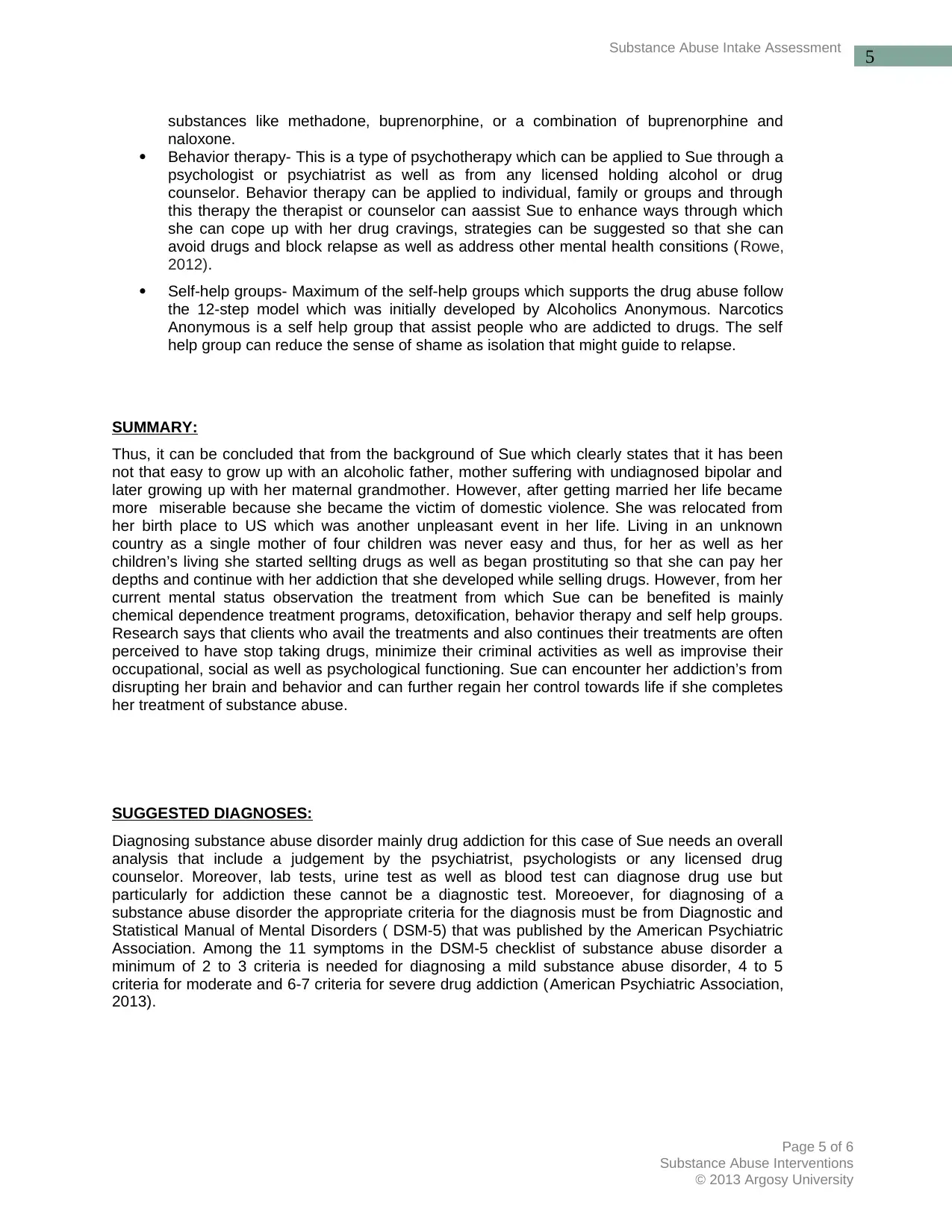
5
Substance Abuse Intake Assessment
substances like methadone, buprenorphine, or a combination of buprenorphine and
naloxone.
Behavior therapy- This is a type of psychotherapy which can be applied to Sue through a
psychologist or psychiatrist as well as from any licensed holding alcohol or drug
counselor. Behavior therapy can be applied to individual, family or groups and through
this therapy the therapist or counselor can aassist Sue to enhance ways through which
she can cope up with her drug cravings, strategies can be suggested so that she can
avoid drugs and block relapse as well as address other mental health consitions (Rowe,
2012).
Self-help groups- Maximum of the self-help groups which supports the drug abuse follow
the 12-step model which was initially developed by Alcoholics Anonymous. Narcotics
Anonymous is a self help group that assist people who are addicted to drugs. The self
help group can reduce the sense of shame as isolation that might guide to relapse.
SUMMARY:
Thus, it can be concluded that from the background of Sue which clearly states that it has been
not that easy to grow up with an alcoholic father, mother suffering with undiagnosed bipolar and
later growing up with her maternal grandmother. However, after getting married her life became
more miserable because she became the victim of domestic violence. She was relocated from
her birth place to US which was another unpleasant event in her life. Living in an unknown
country as a single mother of four children was never easy and thus, for her as well as her
children’s living she started sellting drugs as well as began prostituting so that she can pay her
depths and continue with her addiction that she developed while selling drugs. However, from her
current mental status observation the treatment from which Sue can be benefited is mainly
chemical dependence treatment programs, detoxification, behavior therapy and self help groups.
Research says that clients who avail the treatments and also continues their treatments are often
perceived to have stop taking drugs, minimize their criminal activities as well as improvise their
occupational, social as well as psychological functioning. Sue can encounter her addiction’s from
disrupting her brain and behavior and can further regain her control towards life if she completes
her treatment of substance abuse.
SUGGESTED DIAGNOSES:
Diagnosing substance abuse disorder mainly drug addiction for this case of Sue needs an overall
analysis that include a judgement by the psychiatrist, psychologists or any licensed drug
counselor. Moreover, lab tests, urine test as well as blood test can diagnose drug use but
particularly for addiction these cannot be a diagnostic test. Moreoever, for diagnosing of a
substance abuse disorder the appropriate criteria for the diagnosis must be from Diagnostic and
Statistical Manual of Mental Disorders ( DSM-5) that was published by the American Psychiatric
Association. Among the 11 symptoms in the DSM-5 checklist of substance abuse disorder a
minimum of 2 to 3 criteria is needed for diagnosing a mild substance abuse disorder, 4 to 5
criteria for moderate and 6-7 criteria for severe drug addiction (American Psychiatric Association,
2013).
Page 5 of 6
Substance Abuse Interventions
© 2013 Argosy University
Substance Abuse Intake Assessment
substances like methadone, buprenorphine, or a combination of buprenorphine and
naloxone.
Behavior therapy- This is a type of psychotherapy which can be applied to Sue through a
psychologist or psychiatrist as well as from any licensed holding alcohol or drug
counselor. Behavior therapy can be applied to individual, family or groups and through
this therapy the therapist or counselor can aassist Sue to enhance ways through which
she can cope up with her drug cravings, strategies can be suggested so that she can
avoid drugs and block relapse as well as address other mental health consitions (Rowe,
2012).
Self-help groups- Maximum of the self-help groups which supports the drug abuse follow
the 12-step model which was initially developed by Alcoholics Anonymous. Narcotics
Anonymous is a self help group that assist people who are addicted to drugs. The self
help group can reduce the sense of shame as isolation that might guide to relapse.
SUMMARY:
Thus, it can be concluded that from the background of Sue which clearly states that it has been
not that easy to grow up with an alcoholic father, mother suffering with undiagnosed bipolar and
later growing up with her maternal grandmother. However, after getting married her life became
more miserable because she became the victim of domestic violence. She was relocated from
her birth place to US which was another unpleasant event in her life. Living in an unknown
country as a single mother of four children was never easy and thus, for her as well as her
children’s living she started sellting drugs as well as began prostituting so that she can pay her
depths and continue with her addiction that she developed while selling drugs. However, from her
current mental status observation the treatment from which Sue can be benefited is mainly
chemical dependence treatment programs, detoxification, behavior therapy and self help groups.
Research says that clients who avail the treatments and also continues their treatments are often
perceived to have stop taking drugs, minimize their criminal activities as well as improvise their
occupational, social as well as psychological functioning. Sue can encounter her addiction’s from
disrupting her brain and behavior and can further regain her control towards life if she completes
her treatment of substance abuse.
SUGGESTED DIAGNOSES:
Diagnosing substance abuse disorder mainly drug addiction for this case of Sue needs an overall
analysis that include a judgement by the psychiatrist, psychologists or any licensed drug
counselor. Moreover, lab tests, urine test as well as blood test can diagnose drug use but
particularly for addiction these cannot be a diagnostic test. Moreoever, for diagnosing of a
substance abuse disorder the appropriate criteria for the diagnosis must be from Diagnostic and
Statistical Manual of Mental Disorders ( DSM-5) that was published by the American Psychiatric
Association. Among the 11 symptoms in the DSM-5 checklist of substance abuse disorder a
minimum of 2 to 3 criteria is needed for diagnosing a mild substance abuse disorder, 4 to 5
criteria for moderate and 6-7 criteria for severe drug addiction (American Psychiatric Association,
2013).
Page 5 of 6
Substance Abuse Interventions
© 2013 Argosy University
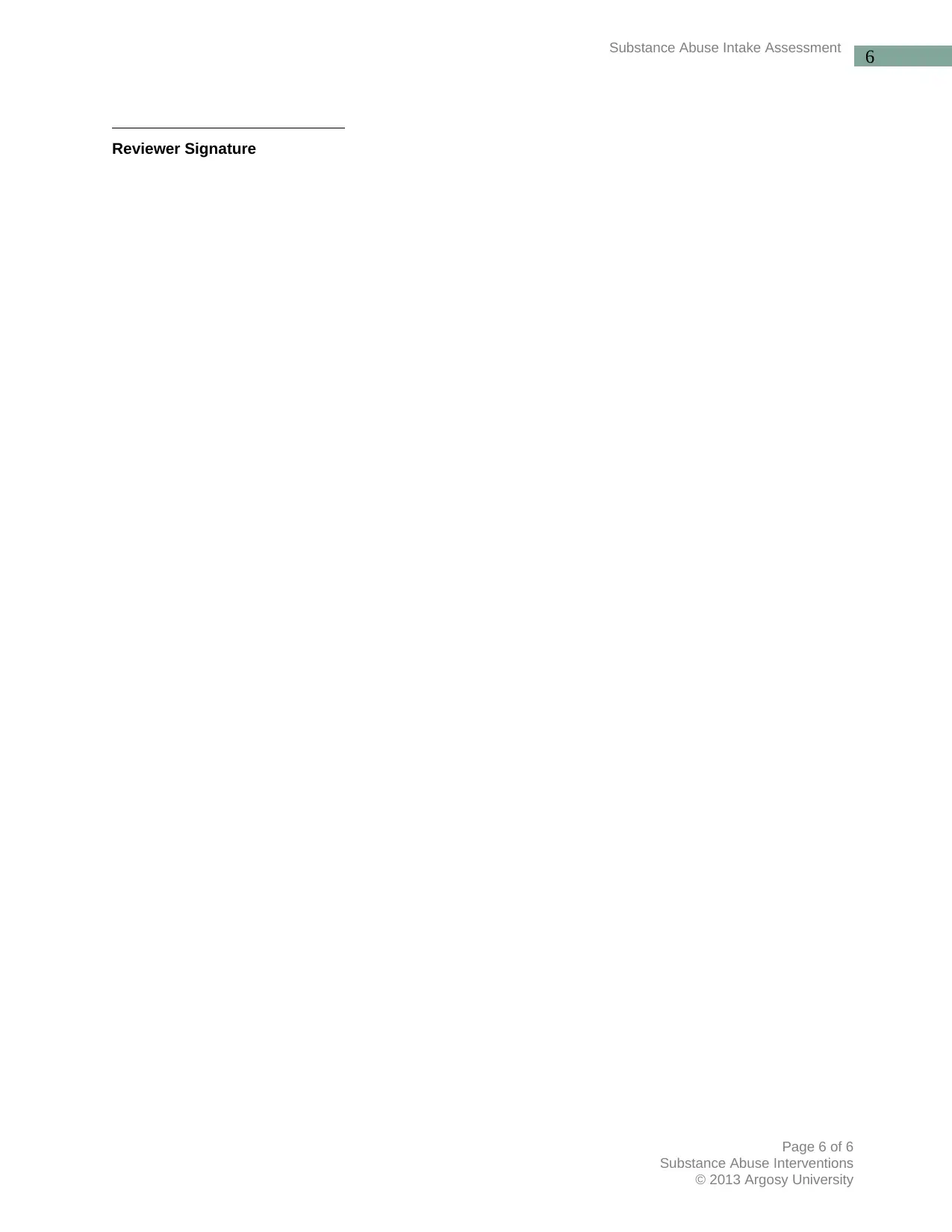
6
Substance Abuse Intake Assessment
Reviewer Signature
Page 6 of 6
Substance Abuse Interventions
© 2013 Argosy University
Substance Abuse Intake Assessment
Reviewer Signature
Page 6 of 6
Substance Abuse Interventions
© 2013 Argosy University
1 out of 6
Your All-in-One AI-Powered Toolkit for Academic Success.
+13062052269
info@desklib.com
Available 24*7 on WhatsApp / Email
![[object Object]](/_next/static/media/star-bottom.7253800d.svg)
Unlock your academic potential
© 2024 | Zucol Services PVT LTD | All rights reserved.